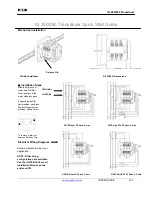
TK-3360
13
Fig. 5 Drive and fi nal amplifi er circuit and APC circuit
图 5 驱动及末级放大器电路和自动功率控制 (APC) 电路
CIRCUIT DESCRIPTION /
电路说明
ANT
RF FINAL
AMP
ANT
SW
LPF
From
T/R SW
(D18)
D201,202
+B
PC/BPF
(IC811)
RF
AMP
Q201
Q205
DRIVE
AMP
Q204
VDD
VG
Pre-DRIVE
AMP
Q203
IC301
(1/2)
IC301
(2/2)
R307
R309
R310
3-2. Driver and Final Amplifi er Circuit
The signal from the T/R switch (D18 is on) is amplifi ed by
the RF AMP (Q201) and pre-drive amplifi er (Q203) to 50mW.
The output of the pre-drive amplifi er is amplifi ed by the
drive amplifi er (Q204) and the RF fi nal amplifi er (Q205) to
5.0W (1W when the power is low).
The drive amplifi er and the RF fi nal amplifi er consist of
two MOS FET stages.
The output of the RF final amplifier is then passed
through the harmonic fi lter (LPF) and antenna switch (D201
and D202) and is applied to the antenna terminal.
3-3. APC Circuit
The APC circuit always monitors the current flowing
through the drive amplifier (Q204) and the RF final ampli-
fi er (Q205) and keeps a constant current. The voltage drop
at R307, R309 and R310 is caused by the current fl owing
through the RF fi nal amplifi er. This voltage is applied to the
differential amplifi er IC301 (1/2).
IC301 (2/2) compares the output voltage of IC301 (1/2)
with the reference voltage from IC811. The output of IC301
(2/2) controls the VG of the RF fi nal amplifi er and the drive
amplifi er to make both voltages the same.
The change of power high/low is carried out by the
change of the reference voltage.
4. Frequency Synthesizer Circuit
4-1. Frequency Synthesizer
The frequency synthesizer consists of the TCXO (X1),
VCO, PLL IC (IC1) and buffer amplifi ers.
The TCXO generates 16.8MHz. The frequency stability
is 1.5ppm within the temperature range of –30 to +60°C.
The frequency tuning and modulation of the TCXO are done
to apply a voltage to pin 1 of the TCXO. The output of the
TCXO is applied to pin 10 of the PLL IC.
The VCO consists of 2VCO and covers a dual range of the
400.00~470.00MHz and the 350.05~420.05MHz. The VCO
generates 350.05~420.05MHz for providing to the fi rst local
signal in receive. The operating frequency is generated by
Q5 in transmit mode and Q4 in receive mode.
3-2. 驱动器和末级放大器电路
来自于 T/R 开关 (D18 ON) 的信号被射频放大器 (Q201) 和
预驱动放大器 (Q203) 放大到 50mW。
预驱动放大器的输出被驱动放大器 ( Q204) 和射频末级放大
器 (Q205) 放大到 5.0W( 当低功率时为 1W)。
驱动放大器和 RF 末级放大器由 2 个 MOS FET 构成。
射频末级放大器的输出通过谐波滤波器 ( L P F ) 和天线开关
(D201 和 D202) 并且送到天线终端。
3-3. 自动功率控制 (APC) 电路
A P C 电路一直监视通过驱动放大器 ( Q204) 和射频末级放大
器 ( Q205) 的电流并保持电流稳定。经过射频末级放大器的电
流的变化会引起 R307、R309 和 R310 的电压降低,此电压送
到差分放大器 IC301(1/2)。
I C301(2/2) 将 I C301(1/2) 的输出电压与来自 I C811 的参
考电压进行比较。I C301(2/2) 的输出电压控制射频末级放大
器、驱动放大器的 VG,使电压保持一致。
功率高 / 低的变化是通过变更参考电压来实现的。
4. 频率合成器电路
4-1. 频率合成器
频率合成器由 TCXO(X1)、VCO、PLL IC(IC1) 和缓冲放大器
组成。
TCXO 产生 16.8MHz 的频率。在温度为 -30 ~ +60℃的范围内,
频率的稳定性为 1.5ppm。进行频率调谐和 TCXO 调制,以便给
TCXO 的针脚 1 提供电压。TCXO 的输出加在 PLL IC 的针脚 10 上。
V C O 由 2V C O 组 成, 并 且 覆 盖 了 400.00 ~ 470.00M H z 和
350.05 ~ 420.05MHz 双波段。VCO 产生 350.05 ~ 420.05MHz
的频率,以提供接收的第一个本振信号。发射模式时,操作
频率由 Q5 产生,而接收模式时,操作频率由 Q4 产生。














































